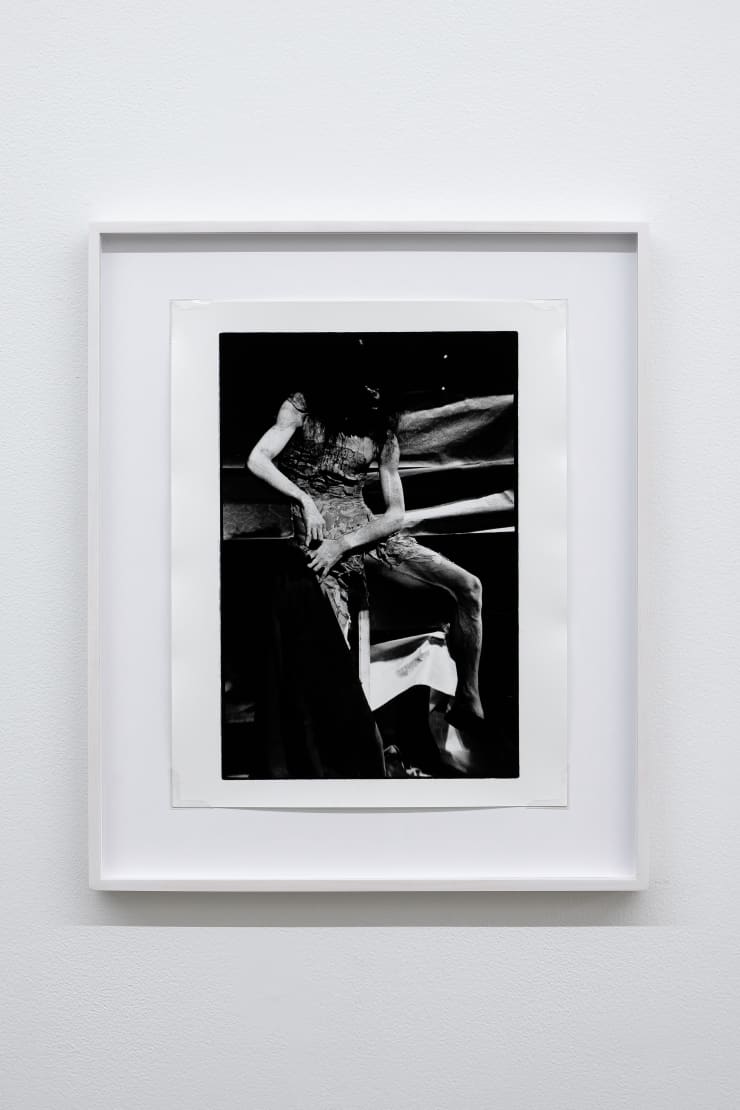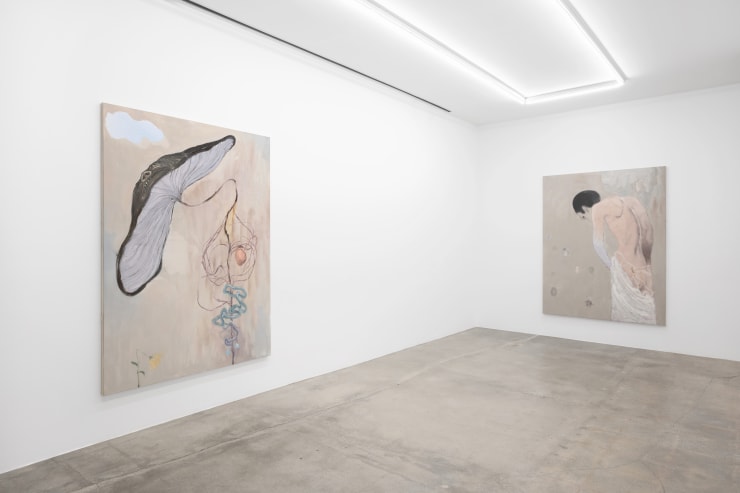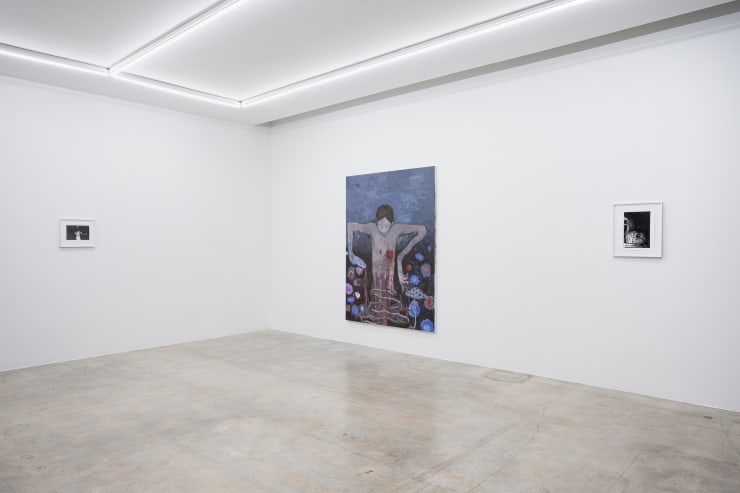Sanya Kantarovsky: TO PRISON – with selections from Tatsumi Hijikata The Last Butoh, Photographs by Yasuo Kuroda
Sanya Kantarovsky: TO PRISON – with selections from Tatsumi Hijikata The Last Butoh, Photographs by Yasuo Kuroda
To Prison is comprised of a new body of work by the New York-based artist Sanya Kantarovsky alongside a series of archival prints by the photographer Yasuo Kuroda, “Tatsumi Hijikata: The Last Butoh,” which document scenes from Hijikata’s legendary Butoh performances held in postwar metropolitan Tokyo.
Butoh is a dance form held largely in darkness, characterized by abrupt, convulsive movements. The performances, seen as akin to an anti-dance, are broadly understood as an expression of social trauma. Hijikata, who settled in Tokyo from the rural Akita prefecture in 1952, began developing the practice of Butoh at the end of that decade while bearing witness to the rapid re-invention of Japan—a society being crafted in the economic image of the Western capitalist superpowers who vanquished and occupied the nation following the second World War.
The grouping of paintings made by Kantarovsky emerges from a sustained engagement with both Hijikata’s oeuvre and the photographic records captured by Kuroda. Human limbs and dense locks of hair gesticulate across several paintings in a state of suspended animation—with the latter often rendered in broad, gestural, calligraphic brushstrokes. The surfaces of the paintings alternate between sensuous, clay-like textures and unsightly, glistening residues of evaporated solvent— rupturing the boundaries between humility and vanity.
The figures in Kantarovsky’s paintings rhyme with those on Hijikata’s stages—both embodying forms animated by exacerbated emotional states. This visual dialogue culminates in a form of communion between two dissonant yet deeply connected approaches to the body as both material and subject. Here, the limits of human form, charged with a perverse erotic desire, are distinctly grounded in both the spiritual and abject capacities of the body.
¹ Tatsumi Hijikata, “To Prison.” TDR (1988–), Spring 2000, Vol. 44, No. 1, pp. 43-48. Originally published as “Keimusho e,” in Mita Bunjaku, January 1961.
 Sanya KantarovskySecret Channels, 2023Oil on canvas87 x 67 in
Sanya KantarovskySecret Channels, 2023Oil on canvas87 x 67 in
221 x 170.2 cm Sanya KantarovskyNo Longer a Dog, 2023Oil on canvas75 x 55 in
Sanya KantarovskyNo Longer a Dog, 2023Oil on canvas75 x 55 in
190.5 x 139.7 cm Sanya KantarovskyGrowth X, 2023Oil and watercolor on canvas75 x 55 in
Sanya KantarovskyGrowth X, 2023Oil and watercolor on canvas75 x 55 in
190.5 x 139.7 cm Sanya KantarovskyBleeding Nature, 2023Oil on canvas75 x 55 in
Sanya KantarovskyBleeding Nature, 2023Oil on canvas75 x 55 in
190.5 x 139.7 cm Sanya KantarovskyI am a Body Shop, 2023Oil on canvas87 x 67 in
Sanya KantarovskyI am a Body Shop, 2023Oil on canvas87 x 67 in
221 x 170.2 cm Sanya KantarovskyIndividual Organic Body, 2023Oil on linen16 x 12 in
Sanya KantarovskyIndividual Organic Body, 2023Oil on linen16 x 12 in
40.6 x 30.5 cm YASUO KURODA白桃房 (小日傘), 1975/2023Signed Y. Kuroda in ink on versoInkjet print (exhibition copy)8 1/4 x 11 3/4 in (21 x 29.7 cm)
YASUO KURODA白桃房 (小日傘), 1975/2023Signed Y. Kuroda in ink on versoInkjet print (exhibition copy)8 1/4 x 11 3/4 in (21 x 29.7 cm)
12 1/2 x 14 1/2 in framed (31.8 x 36.8 cm framed) YASUO KURODAQuiet House, 1973/2023Signed Y. Kuroda in ink on versoSilver halide print11 x 14 in (27.9 x 35.6 cm)
YASUO KURODAQuiet House, 1973/2023Signed Y. Kuroda in ink on versoSilver halide print11 x 14 in (27.9 x 35.6 cm)
15 1/2 x 18 1/2 in framed (39.4 x 47 cm framed) YASUO KURODAQuiet House, 1973Signed Y. Kuroda in ink on versoVintage silver halide print8 x 10 in (20.3 x 25.4 cm)
YASUO KURODAQuiet House, 1973Signed Y. Kuroda in ink on versoVintage silver halide print8 x 10 in (20.3 x 25.4 cm)
12 1/2 x 14 1/2 in framed (31.8 x 36.8 cm framed) YASUO KURODA陽物神譚, 1973Signed Y. Kuroda in ink on versoVintage silver halide print10 x 8 in (25.4 x 20.3 cm)
YASUO KURODA陽物神譚, 1973Signed Y. Kuroda in ink on versoVintage silver halide print10 x 8 in (25.4 x 20.3 cm)
14 1/2 x 12 1/4 in framed (36.8 x 31.1 cm framed) YASUO KURODA陽物神譚, 1973/2023Signed Y. Kuroda in ink on versoSilver halide print11 x 14 in (27.9 x 35.6 cm)
YASUO KURODA陽物神譚, 1973/2023Signed Y. Kuroda in ink on versoSilver halide print11 x 14 in (27.9 x 35.6 cm)
15 3/8 x 18 3/8 in framed (39.1 x 46.7 cm framed) YASUO KURODA陽物神譚, 1973/2019Signed Y. Kuroda in ink on versoSilver halide print8 x 10 in (20.3 x 25.4 cm)
YASUO KURODA陽物神譚, 1973/2019Signed Y. Kuroda in ink on versoSilver halide print8 x 10 in (20.3 x 25.4 cm)
12 1/2 x 14 1/2 in framed (31.8 x 36.8 cm framed) YASUO KURODAQuiet House, 1973/2023Signed Y. Kuroda in ink on versoSilver halide print14 x 11 in (35.6 x 27.9 cm)
YASUO KURODAQuiet House, 1973/2023Signed Y. Kuroda in ink on versoSilver halide print14 x 11 in (35.6 x 27.9 cm)
18 3/8 x 15 3/8 in framed (46.7 x 39.1 cm framed)
Related artist
Artist Exhibited:
Ulala Imai
Kazuo Kadonaga
Kentaro Kawabata
Zenzaburo Kojima
Kisho Kurokawa
Tadaaki Kuwayama
Toshio Matsumoto
Keita Matsunaga
Yutaka Matsuzawa
Kimiyo Mishima
Kunié Sugiura
Takuro Tamayama
Tiger Tateishi
Sofu Teshigahara
Shomei Tomatsu
Wataru Tominaga
Hosai Matsubayashi XVI
Kansuke Yamamoto
Masaomi Yasunaga
Exhibitions:
-2025-
Sea of Mud, Wall of Flame: Satoru Hoshino and Masaomi Ysunaga
KEY HIRAGA: The Elegant Life of Mr. H
-2024-
KYOKO IDETSU: What can an ideology do for me?
KENTARO KAWABATA / BRUCE NAUMAN
SAORI (MADOKORO) AKUTAGAWA: CENTENARIA
Keita Matsunaga : Accumulation Flow
-2023-
NONAKA-HILL ♥ TATAMI ANTIQUES: A holiday sale of unique objects from Japan
TAKASHI HOMMA : REVOLUTION No.9 / Camera Obscura Studies
TATSUMI HIJIKATA THE LAST BUTOH: Photographs by Yasuo Kuroda
Kiyomizu Rokubey VIII: CERAMIC SIGHT
Masaomi Yasunaga: 石拾いからの発見 / discoveries from picking up stones
SHUZO AZUCHI GULLIVER ‘Synogenesis’
Koichi Enomoto: Against the day
Tatsuo Ikeda / Michael E. Smith
Hiroshi Sugito: the garden with Zenzaburo Kojima
Zenzaburo Kojima: This very green
Tomohisa Obana: To see the rainbow at night, I must make it myself
Daisuke Fukunaga: Beautiful Work
- 2021 -
Natsuyasumi: In the Beginning Was Love
Takashi Homma: mushrooms from the forest
– 2020 –
Hosai Matsubayashi XVI & Trevor Shimizu
Sterling Ruby and Masaomi Yasunaga
– 2019 –
A show about an architectural monograph
Yutaka Matsuzawa
Yutaka Matsuzawa through the lens of Mitsutoshi Hanaga
Takuro Tamayama & Tiger Tateishi
Kunié Sugiura
Masaomi Yasunaga
Miho Dohi
Wataru Tominaga
Naotaka Hiro
Parergon: Japanese Art of the 1980s and 1990s
Tadaaki Kuwayama
– 2018 –
Toshio Matsumoto
Kentaro Kawabata
Kansuke Yamamoto
Kazuo Kadonaga: Wood / Paper / Bamboo / Glass
Press:
-2025-
ARTFORUM, Sawako Goda
Artillery Magazine, Sawako Goda
-2024-
Artsy, Nonaka-Hill
Richesse, Nonaka-Hill Kyoto
Bijutsutecho, Nonaka-Hill Kyoto
The Art Newspaper, Nonaka-Hill Kyoto
Meer, Kyoko Idetsu
Bijyutsutecho, Masaomi Yasunaga
Switch, Masaomi Yasunaga
ARTnews JAPAN, Masaomi Yasunaga
Richesse, Masaomi Yasunaga
Art Basel, Daisuke Fukunaga, Imai Ulala
Art Basel, Kazuo Kadonaga, Sofu Teshigahara
-2023-
ADF webmagazine, Yasuo Kuroda, Tatsumi Hijikata
e-flux, Sanya Kantarofsky, Yasuo Kuroda
Los Angeles Times, Kenzi Shiokava
Artillery, Masaomi Yasunaga
Contemporary Art Daily Shuzo Azuchi Gulliver
- 2022 -
Contemporary Art Daily, Tomohisa Obana
ARTE FUSE, Daisuke Fukunaga
Contemporary Art Daily, Daisuke Fukunaga
Contemporary Art Review Los Angeles (Carla), Daisuke Fukunaga
What's on Los Angeles, Daisuke Fukunaga
Hyperallergic, Daisuke Fukunaga
Artillery, Kentaro Kawabata
Larchmont Buzz, entaro Kawabata
- 2021 -
Art Viewer, Natsuyasumi: In the Beginning Was Love
Hyperallergic, Natsuyasumi: In the Beginning Was Love
Art Viewer, Takashi Homma
Hyperallergic, Busy Work at Home
Art Viewer, Busy Work at Home
Hyperallergic, Ulala Imai
Contemporary Art Review Los Angeles (Carla), Ulala Imai
Contemporary Art Daily, Ulala Imai
artillery, Ulala Imai
Special Ops, Ulala Imai
Art Viewer, Ulala Imai
artillery, Matsubayashi & Trevor Shimizu
– 2020 –
Ceramic Now, Sterling Ryby and Masaomi Yasunaga
Hypebeast, Sterling Ryby and Masaomi Yasunaga
Art Viewer, Sterling Ruby and Masaomi Yasunaga
Air Mail, Sterling Ruby and Masaomi Yasunaga
Los Angeles Times, Kaz Oshiro
ArtnowLA, Kaz Oshiro
What's on Los Angeles, Kaz Oshiro
KCRW, Kaz Oshiro
Tique, Kaz Oshiro
Contemporary Art Daily, Kaz Oshiro
Art Viewer, Kaz Oshiro
Contemporary Art Daily, Sofu Teshigahara
Art Viewer, Sofu Teshigahara
KCRW, Sofu Tsshigahara
Hyperallergic, Nonaka-Hill
Los Angeles Times, Keita Matsunaga
– 2019 –
Los Angeles Times, Tatsumi Hijikata
Art Viewer, Tatsumi Hijikata, Eikoh Hosoe
Contemporary Art Review Los Angeles, Tatsumi Hijikata, Eikoh Hosoe
ArtAsiaPacific, Yutaka Matsuzawa
Los Angeles Times, Tatsumi Hijikata
AUTRE, Tatsumi Hijikata, Eikoh Hosoe
Los Angeles Times, Nonaka-Hill
ARTFORUM, Takuro Tamayama, Tiger Tateishi
Art Viewer, Takuro Tamayama, Tiger Tateishi
KCRW, Nonaka-Hill
LA WEEKLY, Nonaka-Hill
AUTRE, Takuro Tamayama, Tiger Tateishi
ArtsuZe, Takuro Tamayama, Tiger Tateishi
ARTFORUM, Review: Tadaaki Kuwayama, Rakuko Naito
Art Viewer, Masaomi Yasunaga, Kunié Sugiura
Los Angeles Times, Masaomi Yasunaga
KQED, Tadaaki Kuwayama, Rakuko Naito
Contemporary Art Daily, Naotaka Hiro, Wataru Tominaga, Miho Dohi
Los Angeles Times, Miho Dohi
Los Angeles Review of Books, Miho Dohi
Bijutsu Techo, Naotaka Hiro, Wataru Tominaga, Miho Dohi
Art Viewer, Miho Dohi
Art & Object, Parergon
COOL HUNTING, Felix Art Fair
Art Viewer, Tadaaki Kuwayama
artnet news, Nonaka-Hill
Contemporary Art Review Los Angeles (Carla), Tadaaki Kuwayama
– 2018 –
Art Viewer, Kentaro Kawabata
Contemporary Art Daily, Kazuo kadonaga
Los Angeles Times, Kazuo Kadonaga
ARTFORUM, Kazuo Kadonaga
Contemporary Art Daily, Shomei Tomatsu
KCRW, Kimiyo Mishima, Shomei Tomatsu
This website uses cookies
This site uses cookies to help make it more useful to you. Find out more about cookies.































